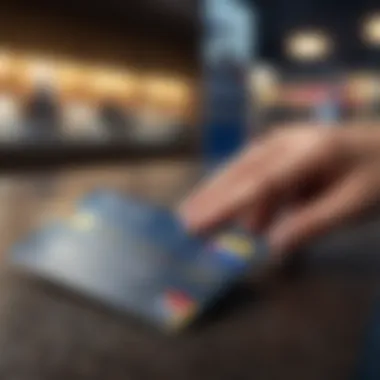Top Prepaid Travel Cards for Hassle-Free Europe Trips


Intro
Traveling in Europe requires careful financial planning. Using the right payment method can significantly enhance your experience, especially when it comes to managing expenses. Prepaid travel cards are increasingly popular for travelers looking for a secure and convenient way to handle their finances abroad. This section provides an overview of this financial product, its key features, and the advantages it offers to various types of travelers.
Overview of Financial Product
Definition
A prepaid travel card is a payment card that is preloaded with funds, allowing users to spend only the amount loaded onto the card. Unlike traditional credit or debit cards, these cards do not link to a bank account. It's a way to control spending while traveling and can be used at millions of locations across Europe.
Key Features
Prepaid travel cards typically include several noteworthy features:
- Multi-Currency Support: Many prepaid cards allow users to hold multiple currencies, making it easy to spend in local denominations.
- Reload Options: Users can reload funds online or through mobile apps, enhancing convenience while traveling.
- Security Features: Most cards come with added security measures, such as chip technology and fraud protection.
- Low or No Foreign Transaction Fees: Unlike some credit cards, prepaid travel cards often charge lower fees for transactions in foreign currencies.
Purpose and Benefits
The purpose of prepaid travel cards is to offer a safe and budgeting-friendly method to carry money abroad. The benefits include:
- Budget Management: By preloading a specific amount, travelers can avoid overspending.
- Easier Access: Finding local ATMs or currency exchange offices can be challenging. A prepaid travel card offers an alternative way to access funds.
- Reduced Risk of Theft: Carrying cash can be risky. Using a card minimizes the risk associated with cash theft.
Understanding Prepaid Travel Cards
Prepaid travel cards have become a popular alternative to traditional banking methods for travelers. Understanding the function and benefits of these cards is essential for any traveler planning a trip to Europe. They offer a secure and convenient way to manage finances while abroad. This section delves into what prepaid travel cards are, their advantages, and their limitations, guiding readers to make informed decisions.
Definition and Functionality
Prepaid travel cards are a specific type of debit cards that you load with a set amount of money before traveling. Unlike credit cards, they do not allow borrowing; instead, they operate on a pay-as-you-go basis. This means you can only spend the money you have already loaded onto the card.
The primary function of these prepaid cards is to facilitate payments in foreign currencies without the need for cash. They can be used for purchases in stores and online, as well as for withdrawing cash from ATMs. Most cards allow you to choose different currencies, which may save on conversion fees while traveling in Europe.
Benefits of Using Prepaid Cards
There are several notable benefits to using prepaid travel cards, especially for those visiting Europe:
- Budget Control: By loading a specific amount, users can manage expenses more effectively and avoid overspending.
- Security: If a card is lost or stolen, the financial risk is limited to the balance remaining on it. This makes prepaid cards safer than carrying large amounts of cash.
- Convenience: Prepaid cards are widely accepted, allowing ease of transactions in various establishments, including hotels and restaurants.
- Reduced Foreign Transaction Fees: Many prepaid cards offer lower fees compared to regular credit and debit cards when used for foreign transactions.
Limitations of Prepaid Travel Cards
While prepaid travel cards have their advantages, there are also some limitations that potential users should consider:
- Reloading Limits: Some cards may have restrictions on how much you can reload or how many times you can do so.
- Inactivity Fees: Certain providers may charge fees if the card is not used for an extended period, potentially reducing the total balance.
- Exchange Rate Variability: Although many prepaid cards offer competitive exchange rates, these rates can fluctuate, affecting how much money actually converts when making purchases.
- Acceptance Issues: Not every establishment may accept prepaid cards, which can lead to inconveniences during travel.
In summary, understanding prepaid travel cards is crucial for making the best financial decisions while traveling. These cards can provide a safe, convenient, and budget-friendly way to handle expenses abroad.
Key Features to Consider
When choosing a prepaid travel card for Europe, certain features play a crucial role in ensuring that you make a well-informed decision. The significance of understanding these key features cannot be overstated, as they directly impact your travel experience and financial management abroad. This section delves into critical elements such as foreign transaction fees, reload options, currency conversion rates, and security features. Evaluating these aspects can lead to better choices tailored to personal needs and preferences.
Foreign Transaction Fees
Foreign transaction fees are often the hidden costs that can accumulate rapidly while traveling. These fees are charged when you make purchases in a currency different from your card's currency. It's essential to scrutinize the fee structure before selecting a card. Some cards may offer zero foreign transaction fees, making them more economical for travelers.
- Cost Impact: A card with a fee of 3% per transaction on purchases can add up quickly. For example, buying a meal for €20 would incur an additional charge of €0.60.
- Fee-Free Alternatives: Options like the Revolut card or Wise card are known for not charging these fees, which can provide significant savings.
Understanding these fees can be the difference in enjoying your trip or stressing over unnecessary expenses.
Reload Options
Reloading your prepaid card should be seamless and convenient. Diverse reload options allow you to deposit funds easily as needed, ensuring you are never left with insufficient balance abroad. Depending on your travel habits, some reload options may work better for you than others.


- Online Reloading: Many providers allow you to add funds via mobile apps or websites quickly.
- Bank Transfers: Some cards may feature bank transfer options, which can be slower but potentially less expensive.
- Retail Locations: Cards like the NetSpend offer reloading in physical stores, though keep in mind possible fees attached to this service.
Prioritize a card that offers reload options compatible with your travel schedule and lifestyle for maximum flexibility.
Currency Conversion Rates
Currency conversion rates directly influence how far your money stretches when traveling. Not all prepaid cards use the same rates for exchanging currencies. Understanding this can lead to more financially sound decisions.
- Market Rates: Cards that use the mid-market rate for conversions often provide better value than those adding a markup.
- Flat Fees: Some services may charge a flat fee for conversions, which can be more predictable.
- Service Provider Rates: Consider checking the provider’s terms, as they may not always offer the best rates compared to local banks or ATMs.
Ultimately, a card that offers favorable conversion rates will help minimize costs while enjoying your travels.
Security Features
Security is paramount when using any financial product, especially abroad. Therefore, assessing the security features of prepaid travel cards is critical. Look for cards that come with robust security measures to protect your finances.
- Transaction Alerts: Cards that provide real-time transaction alerts enable you to monitor activity closely.
- Fraud Protection: Some cards offer zero liability for unauthorized transactions, which can safeguard you from loss.
- Tap and Go Limits: Knowing limits on tap transactions can help mitigate risks. Cards like the N26 also offer temporary card blocking for added security.
By prioritizing security features, you can enjoy peace of mind while traveling and focus on the experience rather than worry about finances.
Top Prepaid Travel Cards for Europe
Card A: Overview and Analysis
Card Features
Card A stands out due to its multi-currency support. This feature allows users to hold different currencies simultaneously. It's beneficial for travelers visiting multiple countries. Another significant aspect is the card's compatibility with contactless payments. This makes transactions quicker and more convenient. Users appreciate the ease of managing funds through a dedicated mobile app. This app provides real-time updates on balances and spending. However, it may have restrictions in some regions.
Cost Analysis
When discussing cost, Card A has an annual fee. This fee is relatively low compared to others on the market. Moreover, it offers competitive exchange rates, which can save money when converting currencies. One unique feature is its fee-free ATM withdrawals in certain countries. However, users should be aware of fees for international transactions outside the designated regions. Understanding these costs can greatly influence a traveler's budget.
Pros and Cons
Assessing the pros and cons of Card A reveals its strong points. Its low annual fee and multi-currency feature attract many users. Yet, it also has disadvantages. For instance, customers report issues with customer support responsiveness. Some find it difficult to resolve problems quickly. Overall, understanding both sides helps users decide if this card suits their travel needs.
Card B: Overview and Analysis
Card Features
Card B offers high security features, making it a popular choice. The two-factor authentication process provides extra protection. Furthermore, it supports instant loading via bank transfers. This is a valuable feature for those needing quick access to funds. Another appealing aspect is its travel insurance options. They can cover unexpected events while traveling, adding value to the user experience. However, some find the initial setup process complex.
Cost Analysis
Card B's cost structure is transparent. It has no hidden fees, which is a major advantage. Users appreciate the clarity regarding costs for loading and foreign transactions. Unique to Card B is the loyalty program, which rewards frequent users with discounts. However, some users may find that the rewards are not compelling enough for regular travel. Assessing these costs helps travelers gauge its overall value.
Pros and Cons
In terms of pros and cons, Card B's security features are its main strength. Additionally, the lack of hidden fees is attractive for budget-conscious travelers. On the flip side, the complexity of the initial setup may deter some. This duality allows potential users to weigh options carefully. Understanding both the positives and negatives ensures a more informed decision.
Card C: Overview and Analysis
Card Features
Card C is notable for its user-friendly interface. Many find it easy to navigate the app to track spending and reload funds. This user-centric design enhances the overall experience for travelers. Moreover, its compatibility with various currencies adds flexibility for users. However, some report limited currency options compared to competitors, which may be a concern for certain travelers.
Cost Analysis
In terms of costs, Card C has both an issuance fee and a monthly maintenance fee. These costs can add up for long-term users. Nevertheless, it offers free ATM withdrawals in select regions, which counterbalances some fees. A unique feature to note is its partnership with specific airlines, granting users bonus points for transactions. This can be advantageous, yet users should carefully consider the implications of these fees on their overall travel budget.
Pros and Cons


The pros of Card C include its intuitive app and strong currency support. However, the additional fees can be a substantial downside. Many users express frustration over these costs over time. Identifying these benefits and drawbacks is crucial for travelers in search of a practical solution.
Card D: Overview and Analysis
Card Features
Card D captures attention with its flexible loading options. Users can load funds via bank transfer or credit card. This versatility proves useful for many who travel sporadically. Another positive is the card's international acceptance at various merchants. Yet, some users mention slow processing times for fund transfers, which can be frustrating in urgent situations.
Cost Analysis
The cost analysis of Card D shows that it has a flat fee for each load of funds. This flat fee appeals to those who prefer predictable costs. On another note, the card also charges international transaction fees. Unique to this card is its discount program, targeting popular travel services. However, users must explore whether these discounts are beneficial for their travel habits.
Pros and Cons
Pros of Card D are its flexible loading options and easy online management. Conversely, the transaction fees might deter potential users. This balanced view informs travelers about what to expect when choosing this card. Knowing the strengths and weaknesses provides an advantage in making sound decisions while traveling.
How to Choose the Right Prepaid Card
Selecting the right prepaid travel card is a crucial part of planning your finances while traveling in Europe. Given the variety of options available, it is essential to consider several key elements that fit your personal needs. Making an informed decision can save you money and provide peace of mind during your travels. This section will help you outline your priorities effectively, ensuring you choose the card that best aligns with your travel style and budget.
Assessing Personal Travel Needs
When choosing a prepaid travel card, the first step is to assess your personal travel needs. Think about how you will use the card abroad. Will you make frequent purchases, or mainly withdraw cash? Identifying your primary spending habits can impact your card selection.
Consider the following:
- Travel Frequency: How often do you travel? If you travel regularly, look for a card with minimal fees and foreign transaction costs. For occasional travelers, prioritize features that offer convenience at your destination.
- Spending Patterns: Evaluate where your money will go. Will you spend mainly in restaurants, shopping, or attractions? If dining out is a priority, look for cards that facilitate easy payments in these places.
- Destination Specifics: Some prepaid cards may have partnerships or better integrations in certain countries. Look for options popular in the regions you plan to visit to take advantage of better rates or no additional fees.
This step will allow you to align the card's capabilities with your expected usage.
Evaluating Costs and Fees
After assessing your travel needs, it is vital to evaluate the costs and fees associated with each prepaid card. Not all cards are created equal regarding charges. Important aspects to examine include:
- Activation Fees: Some cards charge an activation fee when you obtain the card. Make sure this expense fits within your budget.
- Reloading Fees: Investigate how easy it is to reload the card and if there are associated fees. Some cards offer free reloading options,
- Withdrawal Fees: If you plan to withdraw cash from ATMs, know the fees immediately, as they can add up quickly. Certain cards might charge a fee every time you take cash out.
- Foreign Transaction Fees: Look for cards that do not charge foreign transaction fees. This can significantly impact overall savings.
Understanding costs will help you avoid cards that may be financially burdensome in the long run.
Comparing Multiple Options
Finally, once you have narrowed your personal needs and evaluated the costs, the last step is to compare the multiple options available. This process allows you to weigh the pros and cons of each card effectively. Here are a few helpful strategies:
- Create a Matrix: List your top card choices and create columns for their features, fees, and benefits. This visual representation aids decision-making.
- Read User Reviews: Seek insights from travelers who have used these cards. Their experiences can provide valuable context beyond what's offered on the card’s official site.
- Consult Forums: Platforms like Reddit can be helpful in gauging opinion from a community of users. You can find discussions that may highlight nuances of different cards.
By thoroughly comparing options in detail, you can confidently choose a prepaid travel card tailored to your needs, budget, and travel patterns.
Managing Your Prepaid Card
Managing a prepaid travel card is crucial for travelers who want to control their spending while avoiding unnecessary fees. Understanding how to effectively manage your card can enhance your travel experience. This section delves into specific aspects like reloading your card, tracking your expenses, and ensuring you have reliable customer service to navigate any issues that may arise.
Reloading the Card
Reloading a prepaid travel card is an essential component of maintaining its usability during your trip. It allows you to add funds without having to switch cards or rely on cash. Many cards offer various reloading options, such as bank transfers, mobile apps, or retail outlets. Choosing a card with flexible reloading options can make your life easier on the road.
Some key points to consider:
- Ease of Reloading: Opt for a card that allows reloads online or through a mobile app. This way, you won't have to find a physical location.
- Reload Fees: Be mindful of any fees associated with reloading. Some cards might charge you for each transaction, while others do not.
- Time for Reload: If you reload your card through a bank transfer, check how long it takes for the funds to become available.
Tracking Expenses
Tracking your expenses on a prepaid card is not just about budgeting; it helps you avoid overspending and clarifies your financial situation while abroad. Many prepaid travel cards come with companion apps or online platforms that make tracking simple and effective.


Here are important factors to keep in mind:
- Real-time Updates: Use platforms that provide real-time spending notifications. This feature can help you stay within your budget.
- Categorization of Expenses: Some apps allow you to categorize your purchases. This can give you insights into where most of your money goes, making it easier to adjust your spending habits while traveling.
- Currency Tracking: If you are traveling through multiple countries with different currencies, having a system that tracks your expenditures by currency can make it simpler to evaluate your financial standing.
Customer Service and Support
Reliable customer service is a critical component when managing your prepaid card. Issues such as lost cards, unauthorized transactions, or technical problems can occur, especially while traveling. Knowing that you have a responsive support system can relieve anxiety during your trip.
Consider the following:
- 24/7 Support Availability: Look for cards that offer round-the-clock customer service. Time zones can complicate communication, so having support accessible at all hours is beneficial.
- Multiple Contact Options: Whether it's through phone, email, or in-app messaging, a variety of ways to contact customer service gives you flexibility.
- User Reviews and Ratings: Before selecting a card, check online reviews about the customer support experience. This can give you an idea of what to expect if you encounter issues.
Managing your prepaid travel card efficiently can prevent financial stress on your journey and enhance your overall experience.
Common Issues and Resolutions
Understanding the common issues linked with prepaid travel cards is essential for any traveler. This section highlights several critical concerns and offers solutions, ensuring you are better prepared when using these financial tools abroad. Being aware of potential problems helps you avoid unnecessary stress during your travels and keeps your finances secure.
Lost or Stolen Cards
Losing a prepaid travel card or having it stolen can be a frightening experience. When this happens, immediate action is crucial. Most prepaid card providers offer a customer service number that you should keep handy. Reporting the loss or theft allows the issuer to freeze the card to prevent unauthorized transactions.
- Immediate Reporting: Contact the card issuer directly to report the incident.
- Replacement Options: Inquire about getting a replacement card. Many providers send a new card swiftly, sometimes even while you are on your trip.
- Monitor Transactions: Check your transaction history regularly for any unauthorized charges.
Taking these steps can protect your funds and provide peace of mind while traveling.
Disputed Transactions
Disputes over transactions can arise for various reasons, such as unauthorized charges or services not rendered. Addressing these disputes promptly is vital.
- Document Everything: Keep records of all transactions, as this will help in disputing charges.
- Contact Customer Service: Reach out to the card issuer’s customer service to report a disputed charge. They may require certain information and documentation to begin the investigation.
- Timely Follow-Up: Stay in touch with the provider for updates on your dispute status. It can take time, but persistence is important.
Being proactive about disputes ensures you are not held responsible for unexpected charges.
Account Accessibility Problems
Having trouble accessing your prepaid card account can lead to frustration, especially when you are abroad. Connectivity issues, login problems, or forgotten passwords may prevent access.
- Secure Credentials: Always ensure that login credentials are secure and memorable. Use password managers if necessary.
- Mobile App Issues: If you are using a mobile app to access your account, ensure it is up to date. Sometimes, issues stem from outdated software.
- Customer Support: If you encounter access problems, don’t hesitate to contact customer service. They can assist in recovering your account.
Understanding these potential accessibility challenges and their resolutions can help maintain smooth financial management during your travels.
Future Trends in Prepaid Travel Cards
The landscape of prepaid travel cards is evolving rapidly. As technology advances, the features and functionalities of these cards are becoming more sophisticated. Understanding these future trends is crucial for travelers who want to make informed decisions. As competition increases among card providers, innovations are appearing that can greatly enhance the user experience. This section highlights what to expect and consider regarding prepaid travel cards.
Digital Prepaid Cards
Digital prepaid cards are gaining popularity due to their convenience and flexibility. Unlike traditional physical cards, these digital versions can be accessed via smartphones or apps. This means users can easily load funds, check balances, and even freeze the card if necessary, all from their mobile device.
Some key advantages include:
- Instant Access: Users can receive a digital card almost instantly after application, making it easy to access funds right away.
- Lower Fees: Many digital prepaid cards come with fewer fees compared to their physical counterparts. This is because they have lower operational costs.
- Eco-friendly: Digital cards reduce the need for plastic, contributing to a more sustainable approach to travel finance.
As more travelers shift towards online banking and contactless payments, digital prepaid cards will continue to shape how finances are managed abroad.
Integration with Mobile Payment Systems
The integration of prepaid travel cards with mobile payment systems, like Apple Pay and Google Pay, represents a significant trend. This synergy allows users to make payments using their smartphones conveniently.
Benefits of this integration include:
- Convenience: Carrying a smartphone is often easier than carrying multiple cards. Users can pay for any purchase directly from their mobile devices.
- Enhanced Security: Mobile payment systems often include robust security features, like biometric authentication, adding an extra layer of protection for users.
- Rewards and Offers: Some mobile payment apps offer rewards when using linked prepaid cards, incentivizing users to prefer digital transactions.
As technology continues to develop, the synergy between prepaid cards and mobile payment systems will likely become more prominent. This will enable users to navigate their travel expenses with greater ease and security.
The future of prepaid travel cards is not just in traditional finance but in how it integrates seamlessly with emerging digital payment technologies.



